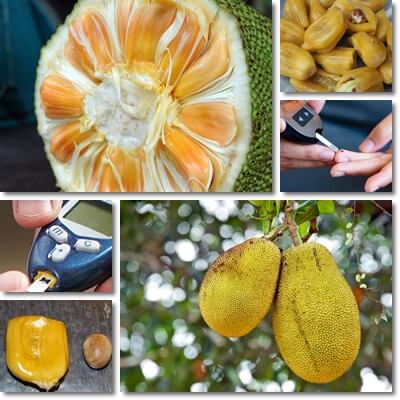Yes, you can eat jackfruit if you have diabetes, but there are some rules to how much you can have at once and how you need to prepare or pair it to reduce its glycemic index and load values and, consequently, effects on blood sugar. The thing to keep in mind is that jackfruit is high in carbohydrates and most of the carbohydrates in the ripe fruit are actually simple sugars which get absorbed relatively quickly and lead to a marked increase in blood sugar just as quickly.
And while a type 1 diabetic person may control the increase in blood sugar with insulin (which they are required to take all the time to help them process carbohydrates from food – type 1 diabetics don’t make insulin), a type 2 diabetic person is likely to experience the rise in blood sugar and its side effects unless on insulin as well. Compared to the ripe fruit which is high in digestible carbohydrates, mostly sugars, and consequently also high glycemic, unripe jackfruit is slightly lower glycemic due to having less digestible carbohydrates (depending on the degree of ripeness), but still not low enough to allow for immoderate consumption with diabetes. So contrary to popular belief, no, jackfruit doesn’t cure diabetes, nor is it particularly good for it if eaten in too large amounts or too often.

When it comes to eating jackfruit with diabetes, you have to make the distinction between the unripe and ripe fruit. The main idea is that the two variants of the fruit have different effects on blood sugar. The unripe fruit has a firmer, more fibrous texture and carbohydrates that are more resistant to digestion which means lesser effects on blood sugar. The firmer, more fibrous texture is also the reason why the unripe fruit is most often eaten cooked. The ripe fruit has a softer pulp that is perfectly edible raw and more readily digestible. Being more readily digestible also means the carbohydrates it provides are processed much faster and stand a higher chance of making blood sugar go up fast.
But what part of the jackfruit is edible? What part of it do you actually eat?
The fruit is made up of an inedible, hard, bark-like, bumpy outer shell that is green when unripe, ripening to yellow-green and finally yellow-brown. Every fruit has a bulky white core containing a milky-white latex – the core is not usually eaten. Between the core and the shell is a rag-like, fibrous white pulp that contains multiple seed coats and their seeds. The rag-like pulp is not usually eaten, but not inedible either (some people cook and eat it). The seed coats (also called arils) and the seeds they contain are the only parts of the fruit that are considered edible, both raw and cooked.
The seed coats are a beautiful golden-orange color when ripe and can be eaten both raw and cooked. When the fruit is ripe, they taste sweet and fragrant, their aroma reminiscent of pineapple, bananas and mango, with a slight overripe scent. The seeds are brown on the outside and milky white on the inside and require cooking – they can be baked, roasted, boiled. Their taste is mild, sweet, milky, nutty. The yellow seed coats are the main edible portion of the fruit and the part of the jackfruit commonly considered a reason for concern in diabetic diets as it’s an important source of carbohydrates.

The glycemic index of jackfruit: 63 (moderate)
The glycemic index (GI) is a scale that estimates how fast the carbohydrates in a food raise blood sugar levels. Below 55 is a low GI. Between 55-69 is a moderate GI. Between 70 and 100 is a high GI. Jackfruit glycemic index is estimated to be around 63 which is a moderate score. The score applies only to the edible seed coats or arils of the ripe fruit, the part most readily eaten.
The unriper the fruit, the lower the GI score of the seed coats. This is because, in the unripe fruit, the carbohydrates are tougher, more resistant to digestion so they take longer to be processed by the gastrointestinal tract. Whereas the seed coats in the ripe fruit, the ones that have a moderate GI value, provide carbohydrates that are fairly easy to be digested – most of the carbs in the ripe fruit are sugars. These are processed fairly quickly and, as a result, raise blood sugar relatively fast.
Does jackfruit raise blood sugar?
Yes. Actually, all foods that contain carbohydrates raise blood sugar levels. The ripe seed coats of the jackfruit, which are soft and sweet, make blood sugar go up fast. Depending on how much you have at once, fluctuations in blood sugar levels can be more or less significant. Now, if you were to eat the unripe seed coats, even if they were cooked (which renders the carbohydrates more easily digestible and the unripe fruit fit for eating), it is likely effects on blood sugar are slightly less prominent than if you were to eat them ripe. This is because, unripe jackfruit have not had time to turn their tougher, fibrous pulp into soft, sweet, sugary pulp.
Which option is good for diabetes: unripe or ripe, cooked or raw?
Diabetics can eat it both ripe and unripe, both raw and cooked and do so safely with their condition. The only important thing to remember is that portion size will determine effects on blood sugar. The smaller the serving of fruit, the lower the intake of carbohydrates and the lesser the effects on blood sugar, which is good for diabetes. The bigger the serving, the higher the intake of carbohydrates and the more pregnant the effects on blood sugar.
How much carbohydrates and sugar in jackfruit?
100 g of the raw fruit provides 23.25 g of total carbohydrates, of which 19.08 g are sugars, another 2.67 g digestible carbohydrates that are not sugars and 1.5 g indigestible dietary fiber that does not contribute to blood sugar levels.
1 cup of sliced jackfruit (estimated weight 165 g) contains 38.36 g of total carbohydrates, of which 31.48 g are sugars, another 4.38 g digestible carbohydrates and 2.5 g indigestible dietary fiber.
How much jackfruit should a diabetic eat?
People are different in the way they respond to various foods and intakes of said foods. Generally, it is advised diabetics have no more than 45-60 g of carbs per main meal (3 meals a day) and consider the estimated carbohydrate content in the foods they’re looking to eat. In the case of jackfruit, 100 g has roughly 23 g of carbs. It’s advised to plan meals ahead and count the carbs you’re getting each meal. Plan at least one meal that is low enough in carbs (and consequently higher in protein) that it leaves room to include some jackfruit, without this affecting your blood sugar too much. Decide on a serving size that fits your remaining carbohydrate quota for the meal.
Tips on how to eat jackfruit safely with diabetes
1) The best way to make jackfruit good for diabetes is to have small portions at a time.
2) Limit intake to one portion a day, preferably not every day.
3) Have the fruit after a meal that is higher in protein and lower in carbohydrates – to account for the carbohydrates in the seed coats and prevent blood sugar spikes.
4) Never on an empty stomach and not together with other fruit.
5) Exercise afterwards to help use up the carbohydrates, prevent weight gain and restore glycemic balance.
6) Combine with foods which are low glycemic and sources of protein and fat to reduce the glycemic effects even further.
7) If it makes your blood sugar go up fast and you feel unwell or sick as a result, you can discontinue consumption altogether (instead, choose low-glycemic options such as pears or apples), reduce serving size considerably or reduce frequency (eat it a lot less often).
